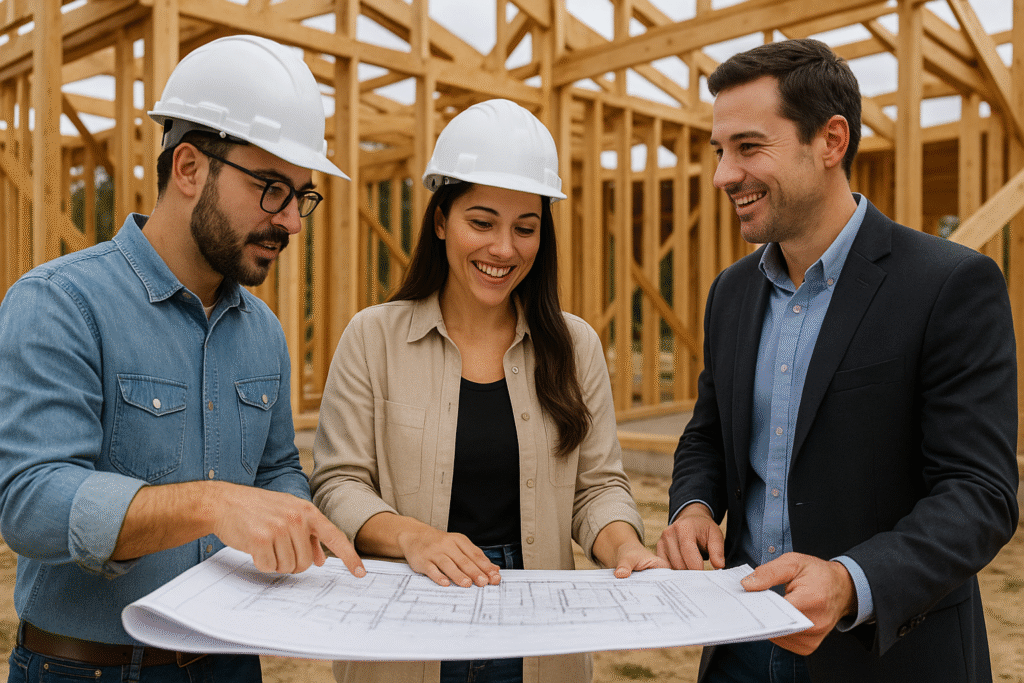
Conventional Construction Loan: Architect Builds Custom Family Home with Single-Close Efficiency

Educational Case Study Disclosure
This case study is hypothetical and for educational purposes only. Scenarios, borrower profiles, loan terms, interest rates, and outcomes are illustrative examples and do not represent current offers or guaranteed terms.
For specific details including down payment requirements, closing cost estimates, interest rate details, closing cost breakdowns, payment calculations, cash-to-close estimates, or an official Loan Estimate, it is highly recommended you schedule a meeting with one of our licensed mortgage advisors.
Learn more:
- Conventional construction loan Reg Z advertising requirements (§1026.24) – CFPB official regulation
- Conventional construction loan Reg Z full text and compliance – Electronic Code of Federal Regulations
- Official conventional construction loan advertising interpretations (§1026.24) – CFPB interpretations
- Conventional construction loan MAP Rule (Reg N) mortgage advertising – Mortgage advertising rules
- NMLS Consumer Access – Verify conventional construction loan lender licensure
Actual loan terms vary by credit profile, property, occupancy, location, market conditions, and lender guidelines. For current options tailored to you, schedule a consultation or apply online.
Ready to explore your options? Schedule a call with a loan advisor.
How This Conventional Construction-to-Permanent Loan Streamlined the Custom Home Building Process
David L., a 42-year-old architect based in Tampa, had spent years designing custom homes for wealthy clients throughout Florida. After helping dozens of families create their dream homes, he was finally ready to build his own. David and his wife Sarah, a marketing director, had been living in a starter home they purchased years ago. With their two children now teenagers needing more space, and both working from home requiring dedicated offices, they decided to sell their current home and build a custom residence perfectly tailored to their family’s needs.
This wasn’t just about upgrading—David viewed building a custom home as creating generational wealth through a unique architectural asset that would serve his family for decades while appreciating substantially in Tampa’s growing real estate market. As an architect, he understood how thoughtful design and quality construction create lasting value that standard production homes can’t match.
David already owned a prime lot in a desirable Tampa neighborhood with mature oak trees and proximity to excellent schools. He’d spent months refining architectural plans that showcased his design philosophy—maximizing natural light, creating seamless indoor-outdoor flow, and incorporating sustainable building practices that would reduce energy costs while increasing long-term value. With a trusted general contractor ready to begin construction and his current home already under contract, David needed construction financing that would make the building process as efficient as possible.
Facing similar challenges? Schedule a call to explore your options.
The Challenge: Finding the Right Construction Financing Structure
David approached construction financing with the same analytical mindset he applied to architectural projects. He researched various construction loan options and quickly identified a major concern: most construction loans required two separate closings—one for construction financing, then another for permanent mortgage financing after the home was built.
Why Are Two Closings Problematic for Conventional Construction Loans?
The two-closing structure created several problems David wanted to avoid. First, it meant paying closing costs twice—once for the construction phase loan, then again for the permanent mortgage. As someone who scrutinized every line item in construction budgets for his clients, David immediately recognized how duplicate closing costs would reduce the capital available for higher-quality finishes and materials that would enhance the home’s long-term value.
Second, the two-closing approach created interest rate risk. Construction takes months, and rates could rise significantly during that period. If David locked a rate for construction but faced much higher rates when applying for permanent financing months later, his monthly housing costs could increase substantially—affecting his family’s financial planning and reducing capital available for wealth-building investments elsewhere.
“As an architect, I design homes to last generations,” David explained. “I needed financing that matched that long-term perspective. The idea of going through two separate loan processes, paying duplicate fees, and facing rate uncertainty during construction felt inefficient and risky. I wanted a structure that protected our financial planning while I focused on building the highest-quality home possible.”
What Conventional Construction Loan Options Did David Explore?
The third challenge was qualification uncertainty. What if something changed during construction—a job transition, credit score fluctuation, or lending guideline adjustments? With traditional two-step construction financing, borrowers face the risk that they might not qualify for permanent financing after construction completes, even though they qualified initially. This creates substantial anxiety during what should be an exciting building process.
David also worried about construction timeline variables. Weather delays, permit issues, material delivery problems, or subcontractor scheduling could extend construction beyond initial timelines. If the construction loan period expired before completion, he’d face extension fees and potential rate adjustments—adding costs he couldn’t fully control.
How Do Conventional Construction Loan Draw Schedules Work?
Additionally, David wanted competitive rates that recognized his strong financial position. He and Sarah both had excellent credit, substantial savings, stable professional incomes, and significant equity from their current home sale. David felt they deserved the most favorable terms available—not elevated rates that some construction lenders charge to offset perceived risk.
“We’d built excellent credit, saved diligently, and were selling a home with substantial equity,” Sarah added. “We wanted our financial strength reflected in competitive financing terms. But many construction lenders quoted rates significantly higher than conventional purchase mortgages, essentially penalizing us for building rather than buying existing. That didn’t align with our wealth-building strategy of creating a custom asset designed for long-term appreciation.”
Experiencing similar frustration with construction financing options? Schedule a call to discuss alternative solutions.
The Discovery: How David Found Conventional Construction-to-Permanent Loans
David’s general contractor, who had built custom homes for decades, recommended exploring conventional construction-to-permanent loans—specifically those backed by Fannie Mae. The contractor explained that these loans offer single-close convenience with competitive rates comparable to standard conventional mortgages, making them ideal for borrowers with strong financial profiles building primary residences.
What Makes Conventional Construction-to-Permanent Loans Different?
Intrigued, David scheduled consultations with lenders offering conventional construction-to-permanent financing. The loan advisor explained how these loans solve the exact problems David had identified. Conventional construction-to-permanent loans close once at the beginning—before construction starts. The rate locks at that initial closing for the entire construction period and permanent financing phase. When construction completes, the loan automatically converts to a permanent conventional mortgage without a second closing, second qualification, or additional closing costs.
“That structure immediately addressed our concerns,” David said. “One closing meant we’d pay closing costs once, not twice. Rate locked at the beginning meant we had complete certainty about our future housing costs regardless of what happened to rates during construction. Automatic conversion to permanent financing meant no requalification risk if anything changed during the building process. It was exactly the efficient, low-risk structure we needed.”
How Do Conventional Construction Loan Rates Compare to Purchase Loans?
The conventional loan advisor also explained that conventional construction-to-permanent loans backed by Fannie Mae typically offer rates comparable to standard conventional purchase mortgages—significantly more competitive than standalone construction loans. This is because Fannie Mae views them as permanent financing from inception, not short-term construction debt. For borrowers like David and Sarah with excellent credit, substantial down payments, and strong incomes, the rates can be quite favorable.
David appreciated that conventional construction-to-permanent loans use the same underwriting standards as regular conventional mortgages—standard debt-to-income ratios, credit score requirements, and down payment guidelines. There’s no exotic qualification process or elevated risk pricing simply because you’re building rather than buying. The focus is on the borrower’s ability to carry the permanent mortgage comfortably, which aligned perfectly with David and Sarah’s strong financial position.
Why Do Conventional Construction Loans Require Builder Vetting?
The conventional loan advisor also explained the builder vetting process. Conventional construction lenders thoroughly evaluate the general contractor’s credentials, experience, licensing, insurance, and track record. They want to ensure the builder has successfully completed comparable projects and has the financial stability to finish the job. For David, whose contractor had an excellent reputation and decades of experience, this thorough vetting provided additional confidence in his builder choice.
“The lender’s careful evaluation of our contractor actually gave us peace of mind,” Sarah said. “They verified his license, insurance, bonding, and references. They reviewed his portfolio of completed projects. This wasn’t just about approving us—it was about ensuring the entire project was set up for success. That aligned with our goal of building a quality asset that would serve our family for generations.”
The Solution: Conventional Construction-to-Permanent Loan Approval Process
David and Sarah worked with their conventional construction loan specialist to structure financing for their custom Tampa home. The process focused on their excellent financial qualifications, the builder’s strong credentials, and David’s detailed architectural plans.
What Documentation Do Conventional Construction Loans Require?
Documentation provided:
- Strong dual income from David’s architecture practice and Sarah’s corporate marketing position
- Excellent credit scores with spotless payment history
- Substantial down payment from current home equity and additional savings
- Appropriate cash reserves demonstrating financial stability
- Comprehensive architectural plans David designed professionally
- Detailed construction budget from licensed general contractor
- Builder’s credentials including license, insurance, bonding, and portfolio
- Builder’s financial statements demonstrating stability
- Construction timeline with realistic completion estimates
- Property appraisal based on completed home value using David’s plans
- Clear title on the lot they already owned
- Sale contract on current home providing equity for down payment
How Long Does Conventional Construction Loan Approval Take?
The approval process:
- Initial consultation – Discussed conventional construction-to-permanent loan structure
- Document gathering – Assembled financial documents, architectural plans, and builder credentials
- Builder vetting – Conventional loan lender thoroughly evaluated contractor qualifications
- Plan review – Underwriter analyzed architectural plans and construction budget for feasibility
- Appraisal – Licensed appraiser valued completed home based on David’s plans and comparable properties
- Underwriting – Evaluated David and Sarah’s debt-to-income ratio, credit, and financial capacity
- Conditional approval – Approved subject to home sale closing and standard conditions
- Current home sale – Closed on existing home providing equity for down payment
- Final approval – All conditions cleared, issued clear to close
- Single closing – Closed on conventional construction-to-permanent loan before breaking ground
- Rate locked – Secured competitive rate for entire construction period and permanent phase
- Construction begins – Contractor breaks ground with financing in place
The conventional construction lender applied standard Fannie Mae underwriting guidelines—the same criteria used for conventional purchase mortgages. David and Sarah’s excellent credit, strong dual incomes, substantial down payment, and appropriate reserves easily met qualification requirements. The builder’s impressive credentials and David’s professionally designed plans gave the conventional loan lender confidence in successful completion.
What Is the Conventional Construction Loan Draw Schedule?
During construction, the conventional construction lender released funds according to a standard milestone-based draw schedule:
- Foundation draw – After foundation completion and inspection
- Framing draw – When framing completed and roof dried-in
- Rough-in draw – After mechanical, electrical, and plumbing systems installed
- Drywall draw – When interior drywall completed and finished
- Trim and cabinet draw – After interior trim and cabinetry installed
- Final draw – At completion with certificate of occupancy issued
Each draw required inspection by the conventional construction lender’s inspector to verify work completion and quality before releasing funds. This protected David and Sarah while providing the builder steady cash flow to maintain construction momentum.
Ready to purchase? Submit a purchase inquiry to discuss your scenario.
The Results: David and Sarah Build Their Architectural Dream Home
David and Sarah closed on their conventional construction-to-permanent loan and watched their custom home take shape over several months. Construction progressed smoothly with draws released at each milestone as planned. The single-close structure eliminated requalification stress, and the locked rate protected them from market volatility during the building period.
What Results Did David Achieve with This Conventional Construction Loan?
Final outcome:
- Single closing with competitive conventional loan rates
- Rate locked for entire construction period and permanent financing
- Avoided second closing and associated duplicate costs
- No requalification required when construction completed
- Construction finished successfully within reasonable timeline
- Loan automatically converted to permanent conventional mortgage
- Timeline: Single closing to move-in ready in several months
- Property: Custom architect-designed home, Tampa, FL
- Features: David’s signature architectural style with sustainable design elements
- Long-term plan: Build generational wealth through unique custom asset designed for decades of family use and appreciation
How Does Conventional Construction-to-Permanent Financing Compare to Two-Step Loans?
Traditional two-step construction loan vs. conventional construction-to-permanent loan:
- Traditional approach: Two closings, duplicate costs, rate uncertainty
- Conventional construction-to-permanent: Single closing, one set of costs, rate locked throughout
- Cost efficiency: Substantial savings from eliminating second closing
- Rate protection: Locked favorable conventional loan rate before construction started
- Requalification risk: ELIMINATED ✓
- Process simplicity: MAXIMIZED ✓
- Financial certainty: ACHIEVED ✓
- Generational wealth building: ENABLED ✓
“The conventional construction-to-permanent loan was the perfect financing structure for our custom home,” David explained. “We closed once, paid closing costs once, and locked a competitive rate that protected us throughout construction. The automatic conversion to permanent financing eliminated any anxiety about requalifying. We saved substantial money compared to two-step construction loans, and we had complete certainty about our long-term housing costs.”
What Are David and Sarah’s Long-Term Wealth Plans?
David and Sarah view their custom home as a cornerstone asset in their wealth-building strategy. As an architect, David designed features that will remain timeless and valuable for decades—high ceilings, abundant natural light, flexible spaces that can adapt as their family’s needs change, and sustainable systems that minimize operating costs while maximizing comfort.
The home’s unique architectural character and quality construction will support strong appreciation in Tampa’s competitive real estate market. Unlike production homes with identical floor plans throughout subdivisions, David’s custom design creates a one-of-a-kind asset that will command premium value when they eventually sell—or that their children might choose to inherit as a family legacy.
As their wealth continues to grow and their children eventually move out, David and Sarah are already thinking about how they might leverage their home equity for future investments. When the time is right, they may consider using a HELOC or Home Equity Loan to access their home equity for investment property purchases or to help their children with down payments—all while preserving the favorable conventional construction loan rate they locked years earlier.
“Building this custom home wasn’t just about having a beautiful place to live,” Sarah added. “It’s about creating lasting family wealth through a unique architectural asset designed by my husband that will serve multiple generations. The equity we’re building here will eventually help us expand our real estate portfolio or support our children’s wealth-building journeys. The conventional construction-to-permanent loan made this vision financially feasible and operationally simple.”
Ready to get started? Get approved or schedule a call to discuss your plans.
Exploring Other Conventional Construction Loan Options?
While David and Sarah used conventional construction-to-permanent financing for their custom primary residence, conventional construction loans work for multiple scenarios:
- Need renovation financing? See how borrowers use conventional renovation loans to transform existing properties
- Want to refinance existing home? See how homeowners use conventional refinance for rate reduction
- View all case studies to find success stories matching your situation
Key Takeaways for Custom Home Builders
What Can Home Builders Learn from This Conventional Construction Loan Success?
- Conventional construction-to-permanent loans offer single-close convenience eliminating second closing and substantial duplicate costs—major savings compared to traditional two-step construction financing (Fannie Mae construction-to-permanent guidelines)
- Rate locked at initial closing protects against increases during construction—critical protection providing complete certainty about long-term housing costs regardless of market volatility during building period
- Automatic conversion to permanent conventional mortgage eliminates requalification risk—no concern about financial changes, credit fluctuations, or guideline adjustments during construction affecting final financing
- Competitive conventional loan rates for qualified borrowers—strong credit, appropriate down payment, and stable income unlock rates comparable to standard conventional purchase mortgages, not elevated construction loan pricing
- Builder credentials critically important for approval—conventional construction lenders thoroughly vet contractors to ensure successful completion, protecting both borrower and lender
- Professional architectural plans strengthen applications—comprehensive designs with detailed specifications demonstrate project feasibility and quality standards
- Think beyond the single transaction—building a custom home creates generational wealth through a unique architectural asset designed for decades of appreciation and family use, with equity that can later be leveraged for additional investments through HELOCs while preserving favorable original rates
Have questions about conventional construction-to-permanent loans? Schedule a call with a loan advisor experienced in custom home construction.
Alternative Loan Programs for Home Builders
If a conventional construction-to-permanent loan isn’t the perfect fit, consider these alternatives:
- FHA Construction Loan – Government-backed construction financing with flexible qualification
- Renovation Loan – Purchase existing home with renovation financing included
- Jumbo Construction Loan – High-balance construction financing for luxury custom homes
- VA Construction Loan – Zero-down construction financing for eligible veterans
- Bridge Loan – Short-term financing for building before selling current home
Explore all loan programs to find your best option.
Helpful Conventional Construction Loan Resources
Learn more about this loan program:
- Complete Conventional Construction Loan Guide – Detailed requirements and process
- Conventional Construction Loan Calculator – Estimate costs and scenarios
Similar success stories:
- How an architect built a custom home with conventional construction-to-permanent financing
- Family builds dream home with single-close conventional construction loan
- View all case studies – Browse by construction type and goals
External authoritative resources:
- Fannie Mae construction-to-permanent guidelines – Official conventional construction loan standards
- Consumer Financial Protection Bureau homebuying resources – Borrower education and protection information
Ready to get started?
- Apply online – Start your application
- Schedule a consultation – Discuss your custom home plans
- Take the discovery quiz – Clarify your building goals
Need local expertise? Get introduced to trusted partners including architects, builders, and real estate attorneys.
Need a Pre-Approval Letter—Fast?
Buying a home soon? Complete our short form and we’ll connect you with the best loan options for your target property and financial situation—fast.
- Only 2 minutes to complete
- Quick turnaround on pre-approval
- No credit score impact
Got a Few Questions First?
Not Sure About Your Next Step?
Skip the guesswork. Take our quick Discovery Quiz to uncover your top financial priorities, so we can guide you toward the wealth-building strategies that fit your life.
- Takes just 5 minutes
- Tailored results based on your answers
- No credit check required
Related Posts
Subscribe to our newsletter
Get the latest insights and mortgage case studies in your inbox.




